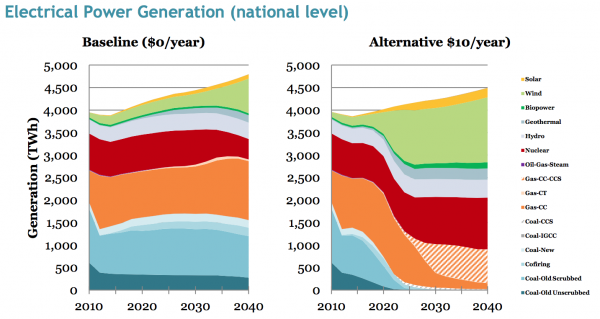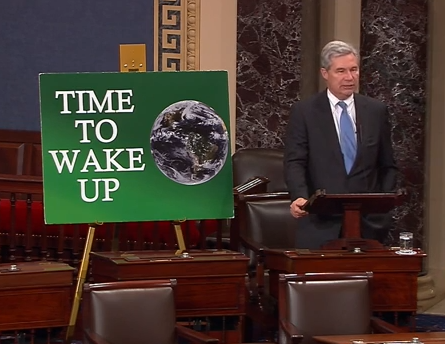Scott Nystrom, a senior economic associate Regional Economic Models (REMI), gave a talk at Brown University about Fee-and-Dividend Carbon Tax, a plan proposed by the Citizens’ Climate Lobby (CCL). The talk presented the effect on the economy and power generation of a steadily rising fee imposed on the CO2 content of fossil fuels. The presentation was a condensed version of a report prepared for the CC by REMI and Synapse Energy Economics.
![gigo_cartoon1[1]](http://www.rifuture.org/wp-content/uploads/gigo_cartoon11.jpg) Here are my impressions, based both on the talk and the report. Nystrom started with an overview of the plan, which can be found on CCL’s beautifully-organized web page:
Here are my impressions, based both on the talk and the report. Nystrom started with an overview of the plan, which can be found on CCL’s beautifully-organized web page:
- Place a steadily rising fee on carbon-based fuels
- Give all of the revenue from the carbon fee back to households
- Make border adjustments to ensure fairness and competition
- This will be good for the economy AND even better for the climate
Border adjustments is short for fees on products imported from countries without a carbon tax, along with rebates to US industries exporting to such countries. Such adjustments serve to level the playing field for international trade.
Based on model calculations, REMI*Synapse makes the following predictions about what implementation of this plan would look like nationally by 2025 by comparing projections with and without the Fee-and-Dividend carbon tax:
- 2.1 million more jobs
- 33% reduction in CO2 emissions
- 13,000 premature deaths saved from improvements in air quality
The fundamentals of the CCL model legislation are perfectly solid, namely that burning of fossil fuels is causing rising global temperatures and poses an imminent threat to the natural environment and an unacceptable risk of catastrophic impacts to human civilization. Also the principle of letting the polluters pay is sensible. The problem, as I see it, is the unsatisfactory implementation of these principles resulting from incomplete understanding of climate science.
The proposal is to put a fee on carbon pollution, but it fails to account for fugitive fracked gas leaking into the atmosphere at the well, from the pipelines or anyplace else down stream. Clearly, the study predates our current understanding of the effects of fracked gas. The unburnt gas that escapes in copious amounts is a much more powerful greenhouse gas than CO2. The net result over the next couple of decades is that conversion to natural gas, as called for in the President’s Climate Action Plan, is very likely to be more dangerous for the global climate than coal and oil.
The Fee-and-Dividend puts a price on CO2 while pollution by fugitive fracked gas continues merrily free of charge. Summing up the climate impact exclusively in terms of a reduction CO2 emissions, as the REMI*Synapse study does, is simply wrong.
Similar criticism applies to the reduction by 13,000 of premature deaths that will result from near-absence of pollution caused by coal fired power plants. The effect of the poisoning of air and water due to fracking are very difficult to quantify with our current understanding.
What we do know does not look good; we are waist deep in the big muddy of an uncontrolled fracking experiment with public health. Notice that we’re not even talking about the effects of the nuclear power generation featured prominently in the study. I guess that the study also manages to suspend the possible health impacts of climate change.
If you can temporarily suspend your disbelief, follow me on to the prediction about power generation. Let’s look at the following figure lifted from the REMI*Synapse study. The figure compares power generation with and without Fee-and-Dividend Carbon tax. The impact on total power generation even as far into the future as 2040 is small. By that time, according to the study, roughly half of the power will be green. The other half will be a a toxic mix of fossil fuel and nuclear energy. The plan will be essentially phase out coal, and the share of nuclear energy will double nationally. Renewable energy increases by about a third relative to the no-fee baseline.

The talk left some of us wondering why the South is projected to have only a minuscule fraction of power generated by wind and solar, while there is a big chunk of nuclear power. Compared this to a proposal by the Solutions Project, a plan for how the world can transition to 100% renewable energy based exclusively on wind, water and sun, with no nuclear power whatsoever.
Time to wrap up. As mentioned, the REMI*Synapse study of pricing carbon emissions fails to price fugitive methane. The results might be interesting for some, but they have no relevance for the world we live in. Computational science has a phrase for such studies: garbage in, garbage out. Of course, this particular problem could be addressed by redoing the study and incorporating our current insights, but there is a more fundamental problem. The study seeks exclusively for market driven solutions. Those proposed by the Solutions Project are simply not in the realm of possible outcomes of any study that take the rules of predator capitalism for granted.
The good people of CCL may think that they have to speak the language of the ruling class to get its attention and they may have a point. It’s not my style, but as long as they do not really hope to get what they seem to wish for, they have my blessing. After all, we’re in this together, and to change everything, we need everyone.


